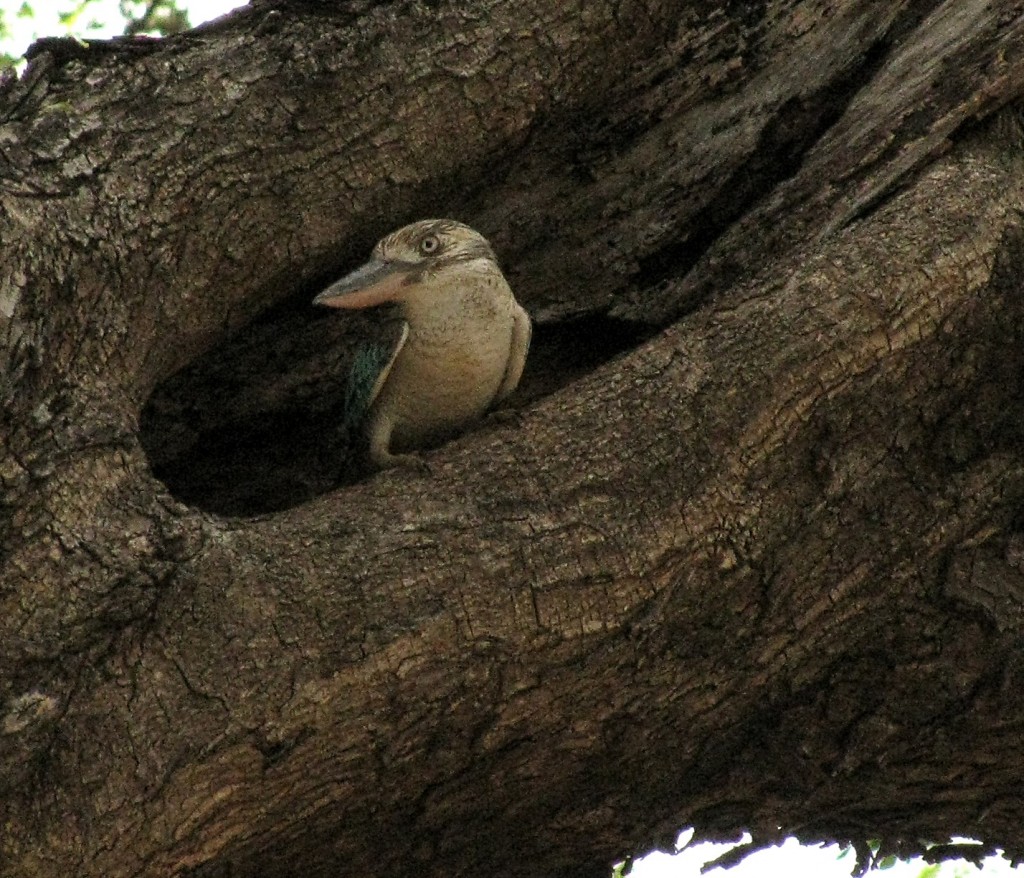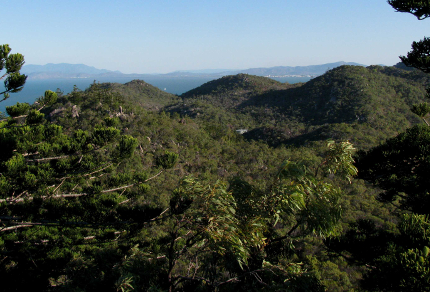In mid-morning, I slipped out for a quick look at the world and was completely captivated by a male great bowerbird flying low across the golf course lawns, with the pink crest on the back of his neck flared wide. Perhaps intent on defending his bower, he made a bee-line toward a row of dense shrubs where – sure enough – a bower was visible, its avenue walls fronted by white and red decorations strewn over the ground. Not far from where I observed the bowerbird, I spotted two blue-winged kookaburras perched on spreading boughs of a rain tree, the birds breaking into harsh barks and flying in turn to a cavity in a massive, nearly horizontal bough. Each peered within, clung to the edge of the cavity with gripping feet and claws, and then flapped back to a leaf-shrouded perch. I believe I’ve found a kookaburra nest, one so close to home I can often wander past to unobtrusively check on the kookaburras’ housekeeping progress.
Today, though, I hurried home, caught up in thoughts of two island adventures Vilis and I have booked for the coming month – Magnetic Island for three days, starting tomorrow, and Hinchinbrook Island for five days, beginning September 9.
Roughly triangular in shape and 5184 hectares in size,1 Magnetic Island is located about 8 kilometres offshore from Townsville2 and is the largest of the dry tropical continental islands found within the Great Barrier Reef World Heritage Area.1 Over half of the island is national park dominated by granite outcrops and eucalypt forest, the latter home to populations of koalas introduced to the island in the 1930’s because of concerns about mainland populations.2 The island’s 40-kilometre coastline1 features rocky headlands and secluded beaches. Dense mangroves on the south shore act as a fish nursery, while offshore eelgrass beds provide food for dugongs and green sea turtles.1 Off the eastern shore, fringing coral reefs contain diverse assemblages of corals, including some massive colonies hundreds of years old.1 Our plan for a long weekend includes hiking woodland trails and walking beaches, visiting ruins of World War II battlements, searching for koalas, and swimming and snorkelling in the waters of a tropical island.
Our plan for Hinchinbrook Island can be summarized in two words – Thorsborne Trail. The island, located offshore from Cardwell about 160 kilometres north of Townsville, has a shape resembling an upside-down, head-and-shoulders sculpture of a woman with gaping mouth and streaming hair. Far larger than Magnetic Island, Hinchinbrook encompasses 39,900 hectares3 and is Australia’s largest island national park.4 Unlike Magnetic Island, which has a few permanent village communities along its east and north coasts, Hinchinbrook is uninhabited with the exception of a resort located at the northern end of the island. Like Magnetic Island, it’s included within the Great Barrier Reef World Heritage Area, although in the Wet Tropics section rather than Dry Tropics section.3 The island is essentially a chain of forested mountains skirted on their eastern slopes by the world-famous Thorsborne Trail. Stretching 34 kilometres, the trail will challenge us with steep climbs and descents, beach walks and tidal stream crossings,5 all undertaken while carrying our camping gear on our backs.
Two islands. Two experiences. Time will tell.

Blue-winged Kookaburra at Potential Nest Site (© Magi Nams)
Today’s birds: blue-winged kookaburras, magpie-larks, mynas, great bowerbirds, noisy friarbird, white-bellied cuckoo-shrikes, peaceful doves, brown honeyeaters, masked lapwings, blue-faced honeyeaters, figbirds, rock doves, little corellas, rainbow lorikeets, bush stone-curlews, welcome swallows, house sparrow, straw-necked ibis, yellow honeyeater, rainbow bee-eaters, white-gaped honeyeater, white-throated honeyeaters, spangled drongo.
References:
1. Australian Government, Department of the Environment, Water, Heritage and the Arts. DRAFT EPBC Act Policy Statement 5.1, Region Magnetic Island, Queensland, September 2008. Accessed 05-Aug-2010. http://www.environment.gov.au/epbc/publications/pubs/magnetic-island-draft-policy-appendix1.pdf
2. Queensland Government, Department of Environment of Environment and Resource Management. Magnetic Island National Park – Nature, culture and history. Updated 08-Dec-2008. Accessed 05-Aug-2010. http://www.derm.qld.gov.au/parks/magnetic-island/culture.html
2. Kym Dungey and Jane Whitlaw. Tropical Walking Tracks of North Queensland. 2007. Footloose Publications, p. 183
3. Queensland Government, Queensland Parks and Wildlife Service. Management Plan Hinchinbrook Island National Park, Townsville/Whitsunday Marine Park planning area, October 1999. Accessed 05-Aug-2010. http://www.derm.qld.gov.au/register/p00201aa.pdf
4. Wikipedia. Hinchinbrook Island. Updated 18-Jun-2010. Accessed 5-Aug-2010. http://en.wikipedia.org/wiki/Hinchinbrook_Island
5. Dungey and Whitlaw, p. 167-171.


